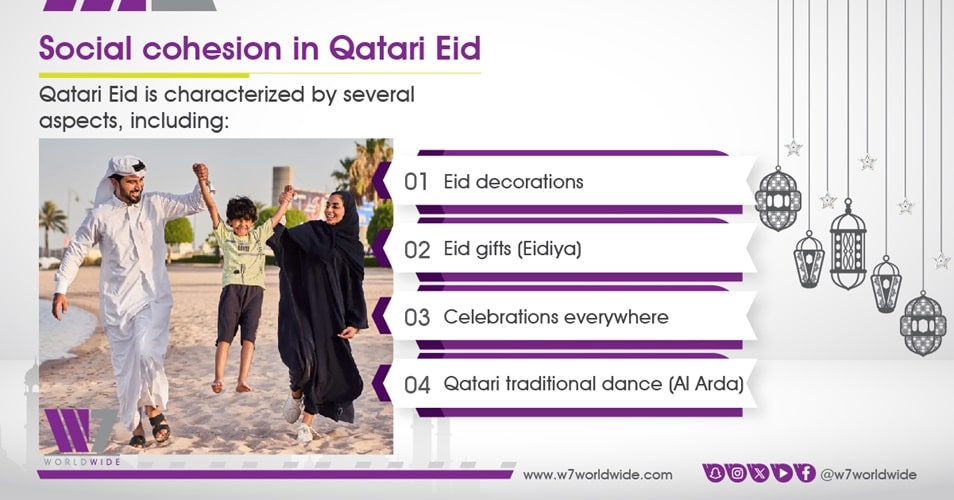“Eid Jakum wa Ramadan Tedaakum” (Eid has come and Ramadan has passed) – this joyous phrase has echoed through generations in Qatar, marking the end of the holy month of Ramadan and the beginning of Eid Al-Fitr festivities. While traditions remain deeply embedded in Qatari society, Eid celebrations have evolved to include a vibrant mix of traditional customs and modern festivities.
Preparing for Joy: A Celebration of Family and Home
W7Worldwide, a leading marketing communications consultancy agency, invites you on a journey into the heart of Qatari Eid traditions. As the ten blessed days leading up to Eid unfold, a flurry of preparations engulfs families across Qatar. Homes transform into vibrant canvases, adorned with colorful decorations that mirror the spirit of celebration. Men proudly don their new thobes, accessorizing with the elegance of the traditional ghutra, agal, and bisht.
Women and children embrace the occasion with stunning attire, whether opting for the timeless elegance of embroidered jalabiyas or contemporary styles. Henna adds another dimension to the festivities, with intricate designs gracing the hands of women. In the pre-Eid period, families shop for new clothes, homes are bathed in vibrant hues, and the air is filled with the aroma of delectable sweets being prepared, like luqaimat, aseeda, and balaleet, which is known as “Afala.”
Eid Night: A Time for Family, Feasts, and Warm Hospitality
On Eid night, excitement fills the air as children eagerly roam their neighborhoods to greet neighbors and collect “Eidiya,” a symbol of goodwill and festivity. Families then come together for a grand feast at the home of the eldest family member (“Al Oud”). The table overflows with a traditional spread featuring “thweiba” (a sacrificed animal) prepared with rice and meat or chicken (“makboos”). This culinary masterpiece is complemented by an array of delectable sweets, pastries, and Arabic coffee.
Adding a touch of tradition to the celebratory ambience, houses are filled with the fragrance of incense during a traditional practice known as “fumigation.” As guests depart, they are treated to a final act of hospitality – being perfumed with oud, a precious fragrance. This gesture embodies the spirit of the proverb, “What follows the oud is sitting,” signifying the continuation of warmth and comfort long after the festivities conclude.
Charity is another cornerstone of Qatar’s strong social fabric and serves as a powerful symbol of social cohesion. During Eid, Qatari families come together to engage in various acts of benevolence, such as donating to charitable causes and opening their doors to visitors throughout the Eid period.
Festive Celebrations: A Fusion of Modernity and Heritage
Eid celebrations in Qatar begin with Eid prayers, followed by family gatherings, gift exchanges, and feasting. Various events and firework displays light up the country, taking place in shopping malls, outdoor spaces like Souq Waqif, the Corniche, Lusail Avenue, public parks, Msheireb, the old port of Doha, and more. Some events showcase traditional crafts and folk games, providing a glimpse into Qatar’s rich heritage.
Qataris celebrate Eid with the traditional dance “Al Ardha.” Men form two lines, separated by meters, and sing and dance to the rhythm of drums and tambourines. This is accompanied by “Al Sheila,” where poets recite verses and engage in call-and-response singing. Sword dances are a common feature, with men clad in the traditional “bisht” and white “shlhat” garments.
A Unique and Captivating Experience
Eid celebrations in Qatar reflect a harmonious blend of tradition and modernity, offering a unique and captivating experience for both locals and visitors alike. The festivities reinforce the values of community, generosity, and cultural heritage, while also showcasing the country’s vibrant and welcoming spirit.




